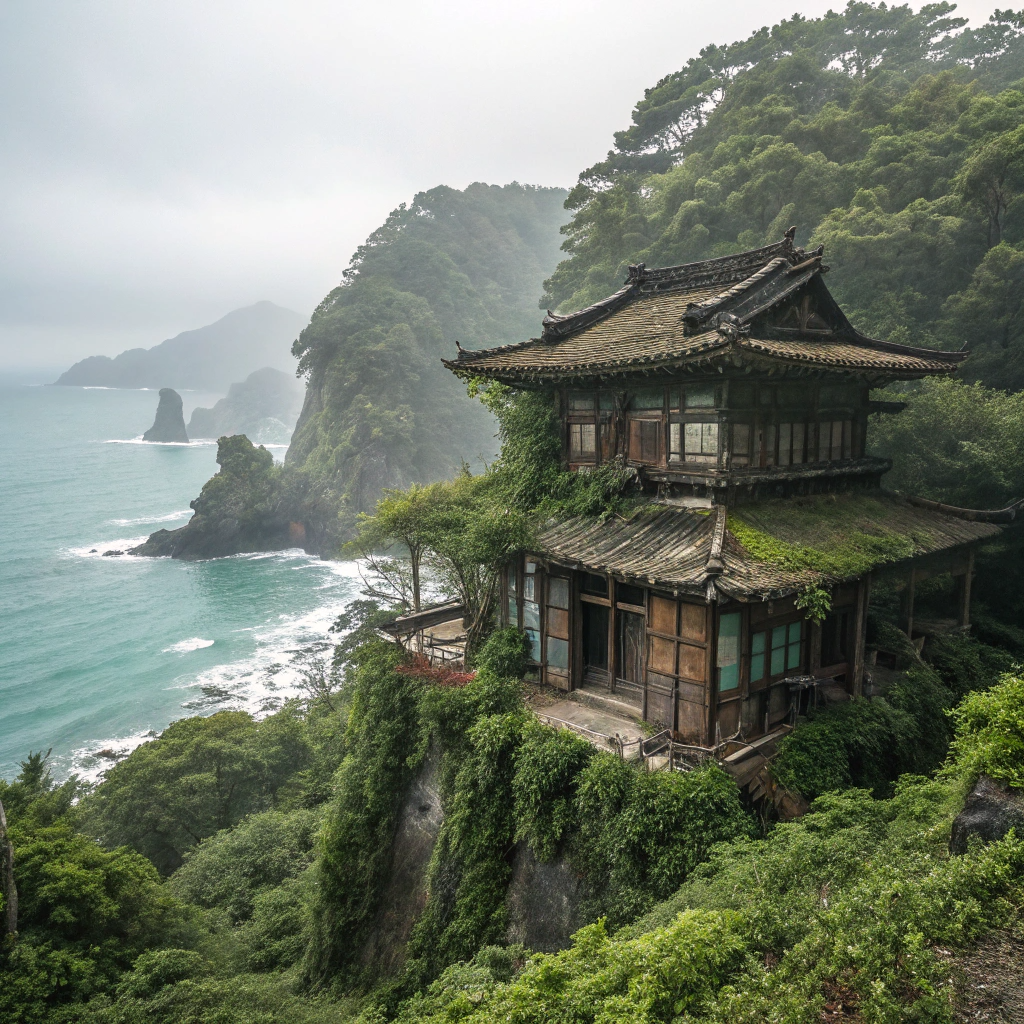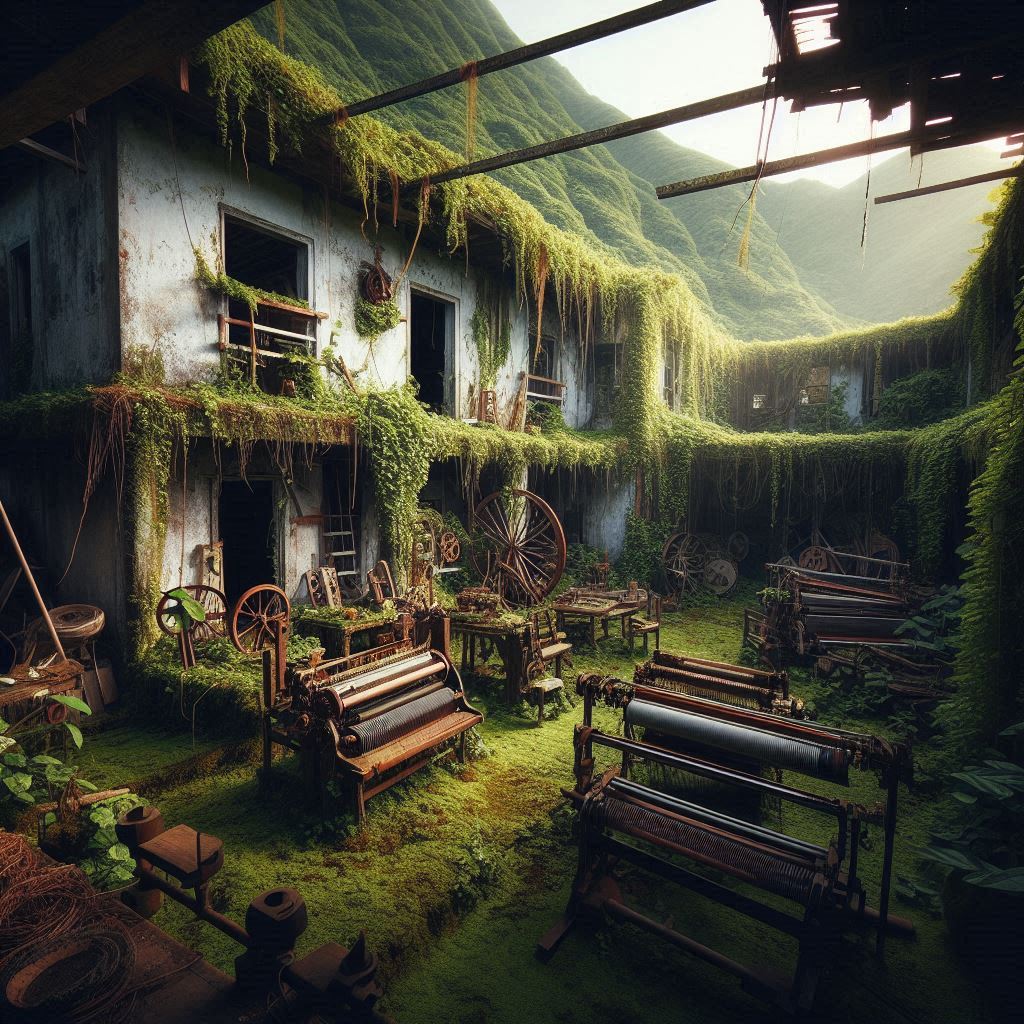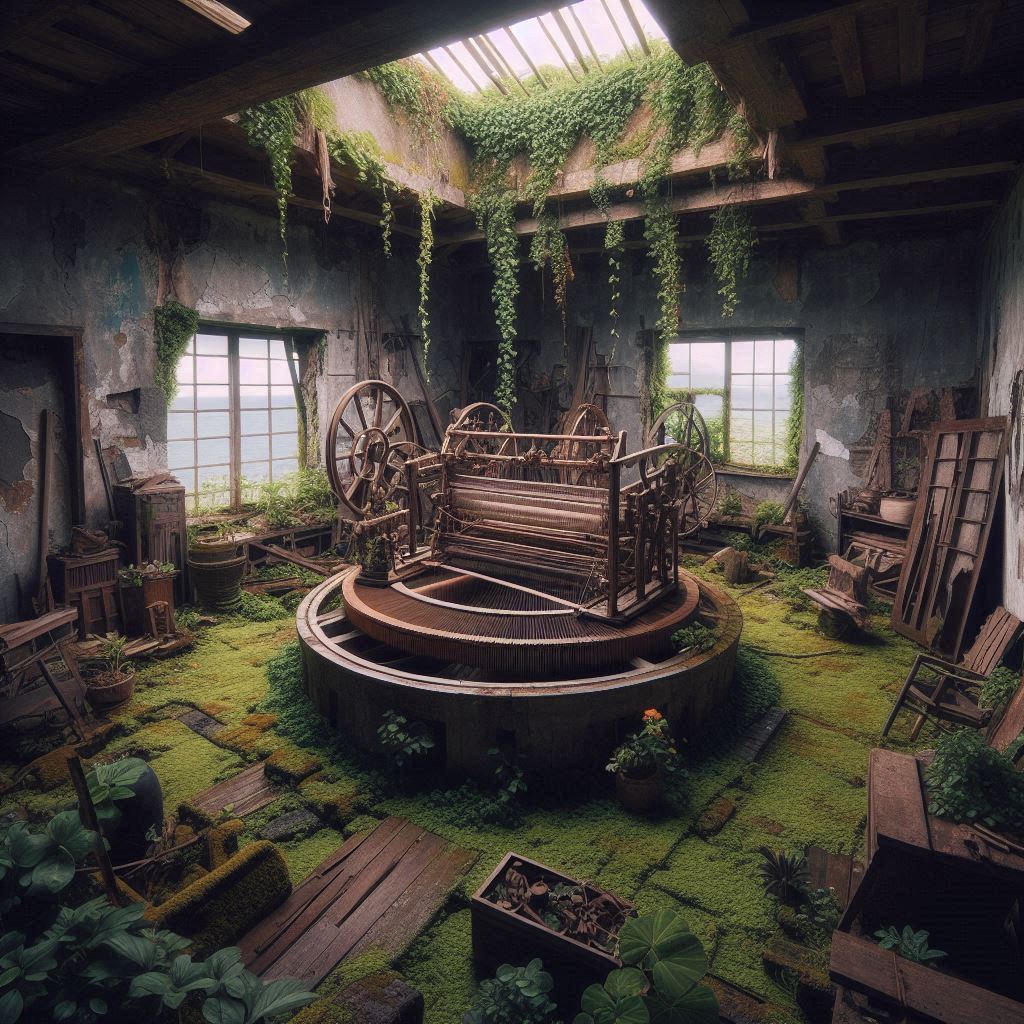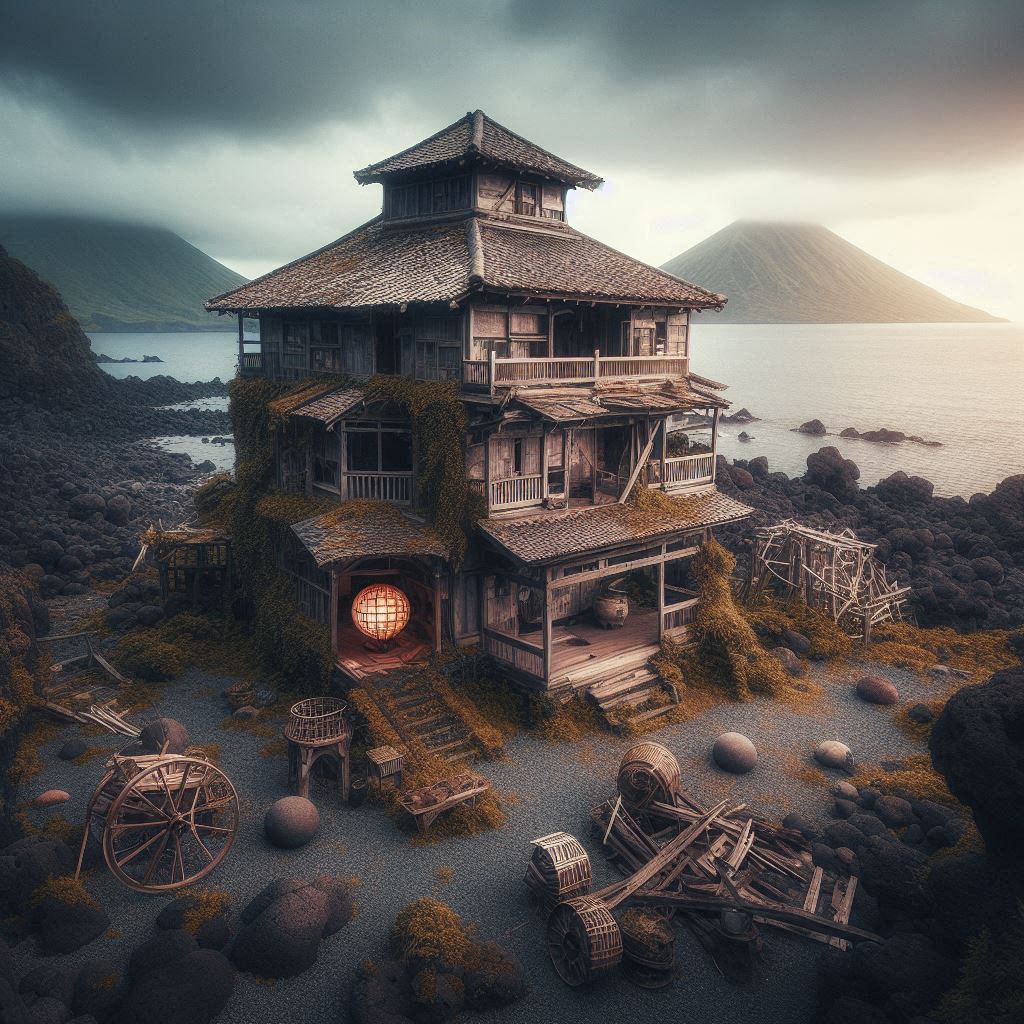Deep in the Pacific, far from the busy streets of Tokyo, lies a volcanic island with a secret. This secret is a forgotten Japanese Weaver’s Mansion—an untouched home that looks like its owners just stepped out for groceries, when in reality, it’s been empty for over 20 years. Step inside and you’ll find not just walls and floors, but a whole family’s story, told through everyday objects, cherished memories, and silent rooms. Join this journey through time as we explore what remains of the Isaki family’s home and their legendary weaving craft.
Discovering a Hidden Gem in the Pacific Ocean
Landing on a windswept island shrouded by the Pacific, we found ourselves far from mainland Japan. The landscape felt almost otherworldly—lush green against volcanic earth, the sea stretching to the horizon. Rumors swirled in local circles that the island was a haven for forgotten places, memories left to collect dust. That possibility sparked an urgent curiosity to see for ourselves.
As we hiked inland, one lonely building caught our eyes. It wasn’t just an old house—it was a time capsule. The mansion stood silent, yet inside it felt as if someone might appear at any moment. Every detail, from slippers and calendars to handwritten letters and sake bottles, seemed frozen in a moment just before the turn of the millennium.
The Island’s Place in History
This remote corner of Japan sits about 285 kilometers south of Tokyo, its volcanic rocks and lush hills shaped by the sea and wind. Officially, the island is governed by Tokyo, linking it to the mainland while it remains very much apart. Unlike many tourist hotspots, this place holds a complex history. In the early 1600s, the shogunate used the island as a holding site for political prisoners during the Edo period.
As recently as the early 2000s, around 6,000 people called it home—a small, tightly knit community, with its own preschool, elementary, and high school. Life here was simple, set to the rhythm of the waves, seasons, and longstanding traditions.
First Impressions: A House Lost in Time
We approached the Forgotten Japanese Weaver’s Mansion as the sun dipped low. The red-painted wood glowed softly against the natural landscape. Intricate woodwork framed the windows and eaves. Despite being abandoned since the early 2000s, the home seemed almost untouched by time.
Inside, dust motes floated through shafts of light, but the tatami mats remained, furniture sat in place, and family portraits watched over every room. Outside, a cat lounged in the overgrown field, its presence adding to the sense of calm and mystery.
Stepping across the threshold felt like walking into the past—each breath seemed to echo with memories.
Meet the Isaki Family: Masters of Weaving and Community
Digging through family letters, awards, and photos, we pieced together the Isaki family’s history:
- Shintaro: The grandfather, a recipient of high state honors for public service.
- Toshiko: Shintaro’s wife, the matriarch.
- Akatoshi: Their son, recognized as both a master weaver and volunteer firefighter, awarded for heroic acts.
- Fumiko: Akatoshi’s wife, also a skilled hand in the craft.
- Their Child: Name respectfully withheld, but evidence of a happy island childhood fills the home.
Weaving ran deep through generations, their mastery recognized by Japan’s Ministry of Economy with “Master of Traditional Crafts” certificates. The father also played a role in burial affairs, underscoring the family’s place at the heart of island life.
The Atelier: More Guesthouse Than Workshop
Beside the main house stood a smaller structure. At first we thought it was the family’s weaving workshop, but the lack of tools told another story. Instead, we found:
- A simple kitchen nook for making meals
- A neat desk with postage and frequent flyer documents
- Comfortable beds, suggesting it hosted overnight family, friends, or visitors
- Postcards and flight tickets hinting at regular trips between the island and Tokyo
Every drawer and shelf remained well-stocked, as if guests could arrive at any moment.
The Genkan: A Traditional Welcome (Even After Decay)






Genkan: The traditional entryway in Japanese homes where shoes should always be left behind before stepping onto tatami floors.
Normally, you’d slip off your shoes, switch to indoor slippers, and tuck footwear into the built-in cabinet. Here, however, shoes and slippers sat abandoned, and with the floors covered in dried leaves and dirt, we left this gesture to tradition.
A fax machine sat ready for use—still a staple of Japanese communication. Velvet-textured wall finishes and an elegant old light fixture set the tone for the beautiful spaces beyond.
Sidebar: Genkan Tradition
In Japanese culture, the genkan marks the boundary between outside and in. Respecting this space keeps the home clean and shows mindfulness for the household.
Spiritual Life: The Buddhist Altar
Moving deeper into the home, a Shinshu Buddhist altar stood as the heart of spiritual life. The altar’s careful woodwork resembled a miniature temple, complete with incense, a rin (prayer bell), and golden statues.
Offerings included bottles of sake, canned peaches, beer, and even cigarettes—tokens honoring family members’ lives and preferences. Some Japanese homes feature both Buddhist and Shinto spaces. Here, devotion stood visible on every carved panel and polished offering bowl.
Shinto Shrine: Honoring Ancestors
Tucked into a sunny corner of the living area, we found a compact Shinto shrine. Paper doors shielded carefully arranged objects—candles, offerings, and small animal figurines. Some believe these altars act as a spiritual link to ancestors, blending Shinto nature-based rituals with Buddhist remembrance. The coexistence of both spiritual traditions is typical in Japan, and the Isaki house was no exception.
The Main Living Space: Center of Family Life
This open area blended tradition with personality:
- Tatami mats for sitting, gathering, and sleep
- Low ceilings with exposed wooden beams—warm and inviting
- Framed portraits with cushions beneath, a gesture to keep them safe and respectful
- Sliding shōji paper doors, delicate and light
- One Western-style bed, a rare find in such a home
In one corner, a low table sat under a simple yet elegant light fixture, ideal for tea or Go games. The combination of Japanese and foreign objects captured a family open to the world, but rooted in their heritage.
Household Treasures: A Time Capsule Preserved
What makes the Forgotten Japanese Weaver’s Mansion so remarkable is how little has changed since the family left. Among the many items we found:
- Futons stacked neatly behind sliding doors for nighttime use
- Drawers of children’s toys and hand-painted watercolors hanging on walls
- Magazines, Shonen Jump comics, VHS tapes, and even LaserDisc karaoke gear
- Letters, photographs, and calendars frozen with dates from 1987 to 2000
- Personal effects of every kind—jackets by the door, fieldwork boots, and everyday utensils
Each object built a clearer picture of daily life, connected to both the past and present.
Family Photographs: A Visual Story
Thousands of photographs littered the mansion, lined up on tables and tucked into envelopes. Some captured brilliant, formal occasions:
A bride in vibrant kimono, smiling beside her parents. A wall of guests grouped for a wedding photo, everyone beaming.
We saw the Isaki weavers at their large looms, hands and feet working in perfect harmony. Tea ceremonies and mochi-making (mochi-tsuki) added color to their daily rituals.
One album recorded the child’s journey—drumming, visiting a train museum, cheering at the front door for the first day of school. With every page we turned, the house felt both grand and comforting, alive with laughter and craft.
Weaving Craft: The Isaki Legacy
The family’s legacy centered on weaving, particularly the production of kibiso—a unique yellow silk native to Hachijojima. This demanding work passed from one generation to the next. In the home, we found:
- Official “Master of Traditional Crafts” certificates from the Ministry of Economy
- Family photos in traditional weaving attire
- Images of intricate silk fabrics, spools, and finished products
- Awards and memorabilia relating to weaving achievements
Sidebar: What is Kibiso Silk?
Kibiso is the outermost layer of the cocoon produced by silkworms, once seen as waste but prized for its strength and texture. Hachijojima’s yellow kibiso fabric is known across Japan for its bold color and durability.
Weaving wasn’t just how the Isaki family made their living—it shaped their status, relationships, and sense of self.
Awards and Honors: Markers of Distinction
Order of the Sacred Treasure
Shintaro, the family’s patriarch, received this high national honor in 1985, awarded by the Emperor of Japan. The Order of the Sacred Treasure recognizes extraordinary public service and dedication—a symbol of respect from the Japanese government.
Heroic Commendations
Akatoshi, the son, earned several awards for firefighting and was even credited with saving a life in 1994. Other certificates revealed his recognition as a “Master of Traditional Crafts,” tying his status not just to heroics, but also cultural stewardship.
Family Pride
Each framed certificate hung with quiet pride, evidence of a family deeply woven into Japan’s fabric of tradition, honor, and service.
Architecture and Craftsmanship: A Masterwork in Wood
The house stood as a testament to traditional Japanese carpentry, which often joins wood without nails or screws. Details that stood out included:
- Exposed beams curving naturally, displaying the wood’s living history
- Ceilings featuring intricate joinery and light fixtures with pull-strings
- Painted shōji doors with patterns echoing woven fabrics
- A mix of classic and newer elements, such as fluorescent lighting and Western furnishings
This blend of old and new gave the home a unique charm, standing apart from typical “machiya” houses in mainland Japan.
Upstairs: Music and Modernity
Climbing to the upper area—an unusual feature for rural Japanese homes—revealed a more modern, relaxed space. Here we noticed:
- English study books (“English for Everybody”) hinting at curiosity and openness
- A record collection, stereo system, and music box playing “Get Back in Love” by Tatsuro Yamashita
- Large beds (almost Alaskan king-size) adjoining each other, rare for a Japanese family house
- Family photos and keepsakes scattered around, but fewer signs of regular use
This area may have served as the parents’ bedroom, or simply a quieter retreat away from the larger living spaces.
The Child’s Room: Creativity and Wonder
Wandering into this bedroom, childhood came alive:
- Children’s watercolor paintings taped lovingly to the walls
- A handmade kite, clearly crafted with care
- Disney books, manga, and board games like Go still boxed
- Calendars with handwritten reminders
- Plush toys, sports equipment, and photos marking first days of school, birthday cakes, and mochi pounding
Every corner told a story of warmth, optimism, and family unity.
Spacious Kitchen and Dining: Ready for a Crowd
The kitchen in the Forgotten Japanese Weaver’s Mansion surprised us with its size—a rarity in rural Japan. It featured:
- Huge cabinets brimming with plates, bowls, and dozens of chopstick holders
- Sake and whiskey bottles lined up side by side
- Drawers for flight tickets and paperwork, reflecting regular travel
- A smaller side room likely for storage or utility use
- Walls decorated with notes, family schedules, and more children’s drawings
The bathroom, built as a separate outbuilding, hadn’t survived the decades so well—it had collapsed, a rare sign of the home’s age.
Games, Pastimes, and Music
Simple pleasures filled the Isaki house. We saw:
- A Go board layered in dust, stones still set out midgame
- Taiko drums resting quietly, once vibrant in the hands of the child or during ceremonies
- Shonen Jump comics, a favorite among Japanese schoolchildren
- Traditional spinning tops and calligraphy sets signifying a well-rounded education
Even as decades passed, every item felt as if it had simply waited for hands to pick them up again.
Fun Fact:
Go, or “igo,” is considered one of the world’s oldest and most complex games, valued in Japan as much as chess is in the West.
Entertainment Tech: The 1990s Live On
Echoes of the late 20th century rang out from:
- A CRT widescreen TV—cutting-edge for its era
- VHS and LaserDisc karaoke systems, still connected to large stereo speakers
- DVD, VHS, and game cartridges for the Super Famicom
- A powerful home sound system, perfect for family karaoke nights
The setup matched the way many Japanese families blended old customs with new excitement—a house where both ancient drums and hi-fi speakers got their moment in the sun.
Handmade Artifacts and Cultural Keepsakes
Displays throughout the house featured:
Dolls and Ceremonial Objects
Handcrafted dolls, shaped for processions or rituals, filled cabinets along with unique trinkets—a paper umbrella for fending off the strong island sun, not rain.
Taxidermy
A beautiful, preserved bird mirrored the shape of crane carvings found above doors and shrines, perhaps intended to watch over the house and its people.
Calligraphy and Art
An expansive shodō calligraphy poster brightened one wall, beneath it a traditional ink set—a sign that the arts were as vital as weaving to this family.
Religious Decorations
Miniature altars, Buddhist and Shinto, filled with tiny fruit offerings, incense holders, and bells.
Personal Effects: Stories in Small Things
Moments of intimacy appeared everywhere:
- Gold necklaces resting where they were last worn, possibly left behind in haste or with trust
- Wallets full of photos, children’s IDs, and home-recorded “Home Songs” albums
- A passport revealing the father’s 1942 birth, placing him in postwar Japan’s earliest years
- Photos showing the construction of the house—hands at work, sweat on brows, dreams built from the ground up
Even with nobody left to claim them, these items radiated pride and care.
Piecing Together Family History
All we know of the Isaki family comes from what was left behind:
Family Members
- Shintaro (grandfather)
- Toshiko (grandmother)
- Akatoshi (father)
- Fumiko (mother)
- Their child, featured in dozens of treasured photos
Letters, albums, and public records hinted at a family who mattered—a family respected on the island and far beyond, through their craft and their kindness.
Why did they leave? The question lingers, unanswered.
Life on the Island: Living Between Two Worlds
Hachijojima, while remote, boasted:
- Local schools (preschool through high school)
- Easy access to Tokyo by flight
- Economic activity centered on weaving, farming, and later, ecotourism and scuba diving
- Small homes, small cars, and a “do it yourself” ethos
Even as some traveled for business, everyday life ran on tradition, community spirit, and self-reliance.
Respectful Exploration: Preserving Honor
Japanese culture prizes respect—especially when it comes to home, ancestry, and spiritual sites. We explored gently, filming without disturbing items or crossing boundaries. The goal: capture, not claim; preserve, not plunder.
For more reflections like these and a look at our ethos as explorers, visit Bros of Decay’s website and gear shop or follow our adventures on Instagram, TikTok, and Facebook.
The Mansion’s Exterior and Natural Surroundings
Step outside, and the Forgotten Japanese Weaver’s Mansion stands tall and proud. The red-painted beams might remind you of Swedish cabins, but with an unmistakably Japanese grace. Overhanging eaves, carved details, and well-weighted doors show the hand of a master builder.
The setting is wild but peaceful—volcanic stones, leafy pockets of green, a sky that stretches forever. In the field, the silent cat remained—perhaps the last keeper of family secrets.
Fragile Beauty: Sliding Shōji Doors
Throughout the house, shōji sliding doors frame every room. Made of thin wood and paper, they glow softly in filtered light. Their fragility shows; bumping them too hard leaves a tear, and upkeep is a constant labor of love. But when whole, they let the outside in, blurring boundaries in the best possible way.
The Unanswered Question
Amid all the objects and images, the biggest mystery persists: why did a strong, respected, and relatively young family leave such a vibrant home behind? Was it personal loss, shifting fortunes, or the changing currents of Japanese rural life? We may never know.
One thing’s certain: the Isaki family’s legacy remains in every woven thread, every photo, and every quiet corner of their abandoned mansion.
Conclusion: The Legacy of the Forgotten Japanese Weaver’s Mansion
In an age where old homes are pulled down and histories disappear, the Forgotten Japanese Weaver’s Mansion endures as a reminder. The Isaki family’s story is preserved in silk and wood, in laughter captured on film, in awards and faded letters. Their house isn’t just abandoned—it’s waiting for someone to remember, to witness, to care.
If you’re drawn to stories like these, and want to support our respectful explorations into the world’s forgotten corners, check out our latest updates and merch at Bros of Decay’s merch page.
The Forgotten Japanese Weaver’s Mansion will likely remain a secret to the outside world, tucked away on its isolated volcanic island. But through these words, its story is told once more—woven back into memory, thread by golden thread.
![]()





